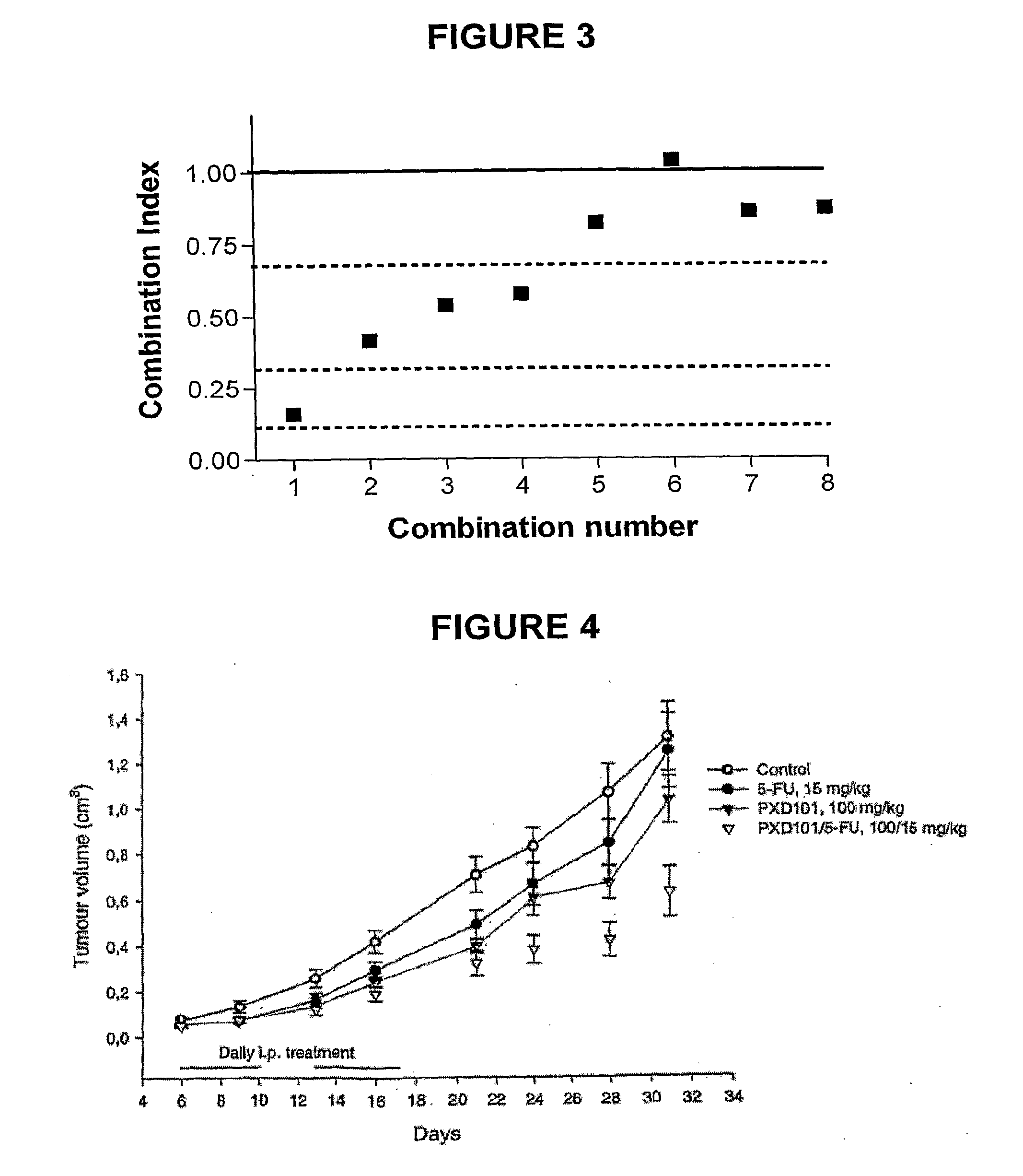Combination therapies using HDAC inhibitors
a technology of hdac inhibitors and inhibitors, which is applied in the field of cancer treatment methods, can solve the problems of not being able to effectively treat long-term, multiple myeloma is difficult to diagnose early, and producing abnormally high levels of immunoglobulins, so as to achieve the effect of treating the disease without increasing patient morbidity
- Summary
- Abstract
- Description
- Claims
- Application Information
AI Technical Summary
Benefits of technology
Problems solved by technology
Method used
Image
Examples
example 1
[0129]The effects of HDAC inhibitors in combination with standard chemotherapeutic agents were tested in vitro to determine the potential clinical use of an HDAC inhibitor (i.e., PXD-101), in combination chemotherapy. See, for example, the Data Annexes below.
[0130]WST-1 proliferation assays were used to assess the anti-proliferative effects of drug combinations. For example, four myeloma cell lines (e.g., JJN3, LP-1, RPMI-8226, U266), the HCT116 human colon carcinoma cell line, and the ovarian cell line, A2780, and its platinum-resistant subline, A2780 / cp7, among others, were used in the combination studies. A commercial program, CalcuSyn®, was employed to determine whether the combined effects are synergistic, antagonistic, or additive.
WST-1 Assay
[0131]Cells were cultured, exposed to PXD-101 alone or in combination with a chemotherapeutic agent, and incubated for a time, and the number of viable cells was then assessed using the Cell Proliferation Reagent WST-1 from Boehringer Mann...
example 2
Clonogenic Assay
[0157]A clonogenic assay was performed essentially as described (Jensen et al., 1993) to determine the anti-proliferative effects of combinations involving PXD-101, in particular a combination involving PXD-101 and 5-FU.
[0158]In this assay, HCT116 or p388 cells were exposed to combinations of PXD-101 and 5-FU for the indicated times. Cells were then plated in 0.3% agar in 6 cm petri dishes with sheep red blood cells as feeder layer in triplicate, and were incubated at 37° C. Plates were counted after 14-21 days. A summary of the results is provided in Data Annex 6. Data Annex 7 and FIG. 3 present the data underlying this summary, and shows the synergy of PXD-101 and 5-FU in the clonogenic assay as calculated by CalcuSyn®.
[0159]Data Annex 6 demonstrates that combinations of PXD-101 and 5-FU are synergistic to strongly synergistic in both cell lines when PXD-101 and 5-FU were co-incubated for 24 hours and when PXD-101 was administered 24 hours after the administration ...
example 3
In vivo Studies
[0160]To investigate the tumour growth inhibitory effect of PXD-101 in a HCT116 colon cancer subcutaneous xenograft model (nu / nu mice), two PXD-101 doses were included, 60 and 100 mg / kg scheduled q1d ×5 / week for 2 weeks. The chemo-sensitising effect of PXD-101 in combination with 5-FU was also investigated. The 5-FU dose was set at 15 mg / kg.
[0161]PXD101 caused significant tumour growth inhibition in a HCT-116 colon cancer xenograft model in nude mice. 5-FU was ineffective in the HCT116 model in the chosen dose regimen, which indicates suboptimal dosing.
[0162]FIG. 4 shows the chemo-sensitising effect of PXD101. HCT116 colon cancer xenograph. Daily i.p. treatments with PXD101 (morning) and 5-FU (afternoon). Mean / SEM, n=10(9).
[0163]Chemo-sensitising effect of PXD101 on 5-FU treatment was indicated. The results indicated synergistic effect of PXD101 and 5-FU after the first treatment cycle where single 5-FU therapy is ineffective at 15 mg / kg. FIG. 4 depicts a graph summar...
PUM
| Property | Measurement | Unit |
|---|---|---|
| enantiomeric excess | aaaaa | aaaaa |
| enantiomeric excess | aaaaa | aaaaa |
| enantiomeric excess | aaaaa | aaaaa |
Abstract
Description
Claims
Application Information
 Login to View More
Login to View More - R&D
- Intellectual Property
- Life Sciences
- Materials
- Tech Scout
- Unparalleled Data Quality
- Higher Quality Content
- 60% Fewer Hallucinations
Browse by: Latest US Patents, China's latest patents, Technical Efficacy Thesaurus, Application Domain, Technology Topic, Popular Technical Reports.
© 2025 PatSnap. All rights reserved.Legal|Privacy policy|Modern Slavery Act Transparency Statement|Sitemap|About US| Contact US: help@patsnap.com



